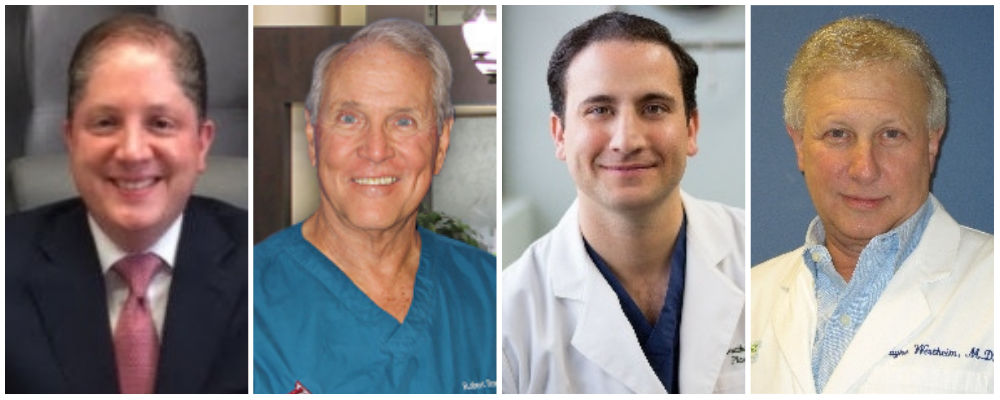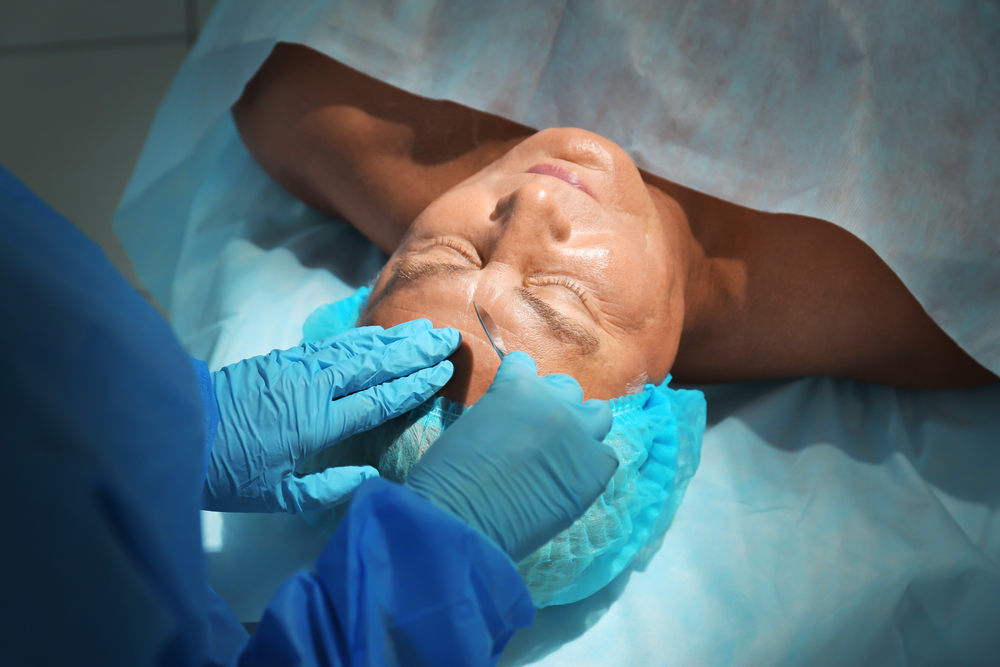More guys are going under the knife for cosmetic purposes than ever before. The rising popularity of these 10 procedures is a sign that many men have finally come to embrace plastic surgery as the norm.
Cosmetic procedures performed by qualified physicians have always been a popular option for those wishing to refine specific areas of their bodies, but let’s face it, even in 2019, the practice is still generally associated with women. This might have been a perfectly reasonable assumption as recently as ten years ago, but as the times have changed so have attitudes.
Nowadays, it’s not the slightest bit uncommon for men to turn to plastic surgery or other medically supervised treatments in the quest for cosmetic enhancement — for all sorts of reasons, not strictly vanity.
As one example, studies repeatedly confirm that refined, physically attractive men are more likely to succeed in the workplace and lead romantically fulfilling lives. Pretty important stuff.
Most male plastic surgery procedures are equally popular among women, but there are others, not surprisingly, which tend to hold more specific appeal depending on one’s gender.
For example, gender reassignment candidates aside, you’re not likely to find too many guys looking to have their breasts augmented, same as you won’t come across many women especially concerned about pectoral implants or gynecomastia.
Here, in no specific order, are ten of the most popular plastic surgery procedures among American men.
1. Blepharoplasty (eyelid rejuvenation)
According to the American Society of Plastic Surgeons (ASPS), blepharoplasty, or eyelid rejuvenation, is currently the single most popular plastic surgery procedure requested by American men. The primary benefits of this surgery are the removal of bags from under the eyes and fewer fine lines, which in turn helps people to look younger.
Plus, it’s not uncommon for patients with a great deal of extra skin on their upper eyelids to experience improved vision after blepharoplasty surgery — which is a pretty nice bonus.
Another factor contributing to the popularity of this procedure is that scarring is relatively minimal. Given guys tend to be slightly more guarded than women when it comes to unwittingly advertising to the world that they’ve had cosmetic work done, an anti-aging treatment like blepharoplasty, which leaves little evidence behind, becomes that much more of an attractive option because of it.
Samuel J. Lin, MD, a Boston-based multiple board-certified surgeon who, among a series of impressive credentials, is an Associate Professor of Surgery at Harvard Medical School, puts it this way:
“In terms of scars, those emanating from blepharoplasty generally heal very well and are fairly well concealed. Blepharoplasty of the upper or lower eyelid can make a significant difference towards creating a brighter, more awake appearance to the eyes. Which is one reason why the upper eyelid lift is more popular than lower eyelid procedures, even if visible scarring is, unfortunately, more significant with the upper eyelid.”
With blepharoplasty, your surgeon makes two incisions on the upper lid or one just below the lower lash line. Excess skin and fat is then removed or repositioned and the muscles tightened before the incisions are closed.
A blepharoplasty typically requires no more than one overnight stay in the hospital, and is occasionally even performed on an outpatient basis. While redness and swelling around the eye area is common, pain is usually minimal and restricted to the incision sites.
Other side effects experienced during recovery can include excessive tearing, dry eyes, blurry vision, and sensitivity to light. Full recovery for most patients takes several weeks.
Average cost of a blepharoplasty: Eyelid surgery generally costs a little under $3,000, although like every other procedure listed here, prices can vary dramatically from region to region and doctor to doctor.
Just remember to verify that the provider you settle upon is board-certified by the American Board of Medical Specialties (ABMS), the American Board of Plastic Surgery (ABPS), or a similarly legitimate body, “legitimate” being the operative word here, especially if their price is considerably lower than everyone else’s.
You certainly don’t want to take chances with your health just to save a few bucks with a practitioner who may or may not be qualified to perform eyelid surgery, Distressing as it may be, these practitioners are far more common than anyone would like. Be careful.
2. Lower rhytidectomy (neck lift)
Men who are concerned about the dreaded “turkey neck” often feel self-conscious because it weakens their jaws and makes them appear heavier than they really are. A lower rhytidectomy can eliminate double chins, restore strong jaw lines, and make the neck appear longer, thus giving the patient a thinner appearance.
There are two types of neck lifts: traditional and limited.
For a traditional neck lift, the surgeon begins the incision around the hairline of the patient’s sideburns and then brings it around the ear, ending in the hairline at the back of the head. Fat is then removed or redistributed and, in some cases, the platysma muscle is tightened before any excess skin is removed and contouring is created. If liposuction is also required, the surgeon will make another incision just under the skin to remove fat.
A limited incision involves smaller cuts around the ear and typically results in a less dramatic change.
The inevitable pain, swelling, and bruising that occurs after a neck lift can be reduced with oral and topical medications, bandages, and by keeping one’s head elevated above the heart.
It’s also important to avoid twisting and turning your head, and you should never put ice on the affected area as the cold will restrict the blood flow and possibly kill the skin. For most patients, recovery time ranges from two to four weeks.
Average cost of a necklift: In the U.S.A., a lower neck lift runs from $4,500 – $7,000.
3. Facial fillers and Botox
Over 450,000 Botox treatments were performed on men last year. And why would men want to get Botox, you ask? For the same reasons as women, of course.
These injections are proven to temporarily remove fine lines and wrinkles — especially severe crow’s feet and frown lines — making you look younger and more rested. Men and women alike love Botox because it’s relatively painless and affordable when compared to surgical procedures. You can literally get them on your lunch break.
Botox can also be used to address excessive underarm perspiration, with the manufacturer claiming that it can effectively reduce severe sweating for over six months at a time. However, more effective and permanent options such as miraDry, a non-invasive procedure that delivers electromagnetic energy to eliminate sweat glands, are rapidly gaining in popularity.
Hyaluronic acid fillers such as Restylane and Juvéderm are also popular among men, and offer a wide range of applications. They can be used in the under-eye area, or to fill deep creases and wrinkles in the ears and chin. Fillers are also offer an effective treatment for deep pitted acne scars.
Average cost of Botox and fillers: Injectable treatments are relatively inexpensive, costing approximately $400 per area for fillers and $350 for Botox. However, it’s important to remember that these injections only provide a temporary fix. Botox results last between three and six months, and hyaluronic acid fillers generally last between four and nine months.
4. Rhinoplasty
Rhinoplasty helps men look better and feel more confident by changing the size and shape of their nose, while removing bumps and filling in depressions if need be. Of course, not every guy going for a nose job is having the work done strictly for cosmetic reasons. Many men with broken noses or breathing problems resulting from a deviated septum will also seek rhinoplasty.
During rhinoplasty, surgeons make their incisions either inside the nose or on the strip of tissue between the nostrils before reshaping the inner structure of the nose. It’s not uncommon for cartilage taken from an ear or rib to be used to help give a nose its new shape.
Once the surgeon has completed the procedure, a stent and packing will be used to support the patient’s nose while it heals. Bandages are placed on the outside of the nose, while pain medication is often dispensed to address any post-surgery discomfort.
It typically only takes a few weeks for the swelling to dissipate, but up to one year for the tissue of the nose to be fully refined into the desired shape. With rhinoplasty, there is also the small risk of nasal septal perforation, in other words, accidentally puncturing a hole in the septum.
Average cost of a rhinoplasty: In the United States, patients can expect to pay between $4,500 and $6,000 for rhinoplasty surgery.
5. Mentoplasty (chin augmentation)
Men with genetics that failed to provide them with strong, masculine chins often choose to undergo chin augmentation, also known as mentoplasty. This procedure enhances or reshapes the chin area and is sometimes performed in conjunction with a rhinoplasty so the resulting facial proportions are more aesthetically pleasing.
The incisions needed for a chin augmentation are typically made inside the mouth between the lower lip and gums, as well as below the chin. Once an incision has been made, the surgeon proceeds to sculpt tissue and add the implant.
As with most, if not all, surgical procedures, there are certain risks involved with chin augmentations as well, among them migration of the actual implant and potential numbness caused by the destruction of several small nerves in the general area.
Nevertheless, complications from mentoplasty are rare and recovery times short, with many patients reporting they were able to comfortably go back to work within 5 days of their operation. There will definitely be some bruising and swelling afterward but most of it will have subsided in less than a week. Once all is said and done, the chin implant should be completely healed after 3 or 4 months.
At the same time, there are other options available to help do battle with the cursed double-chin as well. And better, these are non-invasive options to boot, albeit they’re a little pricey.
Dr. Frank Ferraro, an accomplished plastic surgeon based in scenic Paramus, New Jersey, recommends Kybella, a popular injectable that allegedly kills fat cells, as a practical alternative to mentoplasty.
Dr. Ferraro believes that, outside of surgery, “Kybella is the best technology to address the chin. It’s FDA approved, safe and effective. There is little downtime involved and it’s done without general anesthesia in the privacy of my office.”
Average price of a chin augmentation: Prices for chin augmentation surgery vary quite dramatically, ranging from $2,500 – $7000 depending on where you live, the reputation and experience level of the surgeon operating on you, and a few other key variables.
Going the Kybella route costs about the same amount of money, with the average price for a full treatment being approximately $5,500 in the United States.
6. Liposuction
Liposuction is another plastic surgery option that’s proven itself to be very popular among men. This ubiquitous procedure involves removing excess fat deposits and creating new body contours. While patients typically expect treated areas of their body to appear slimmer and more proportioned afterward, it’s important to remember that liposuction is not a weight loss method.
Dr. Ferraro says men like liposuction for their flanks and abdomen.
“It’s effective and pinpoints the changes they want to make,” he explains. “I find younger men tend to ask for it the most. In my own practice I use tumescent liposuction because I can be aggressive without incurring side effects. I don’t think external types of liposuction (like CoolSculpting) are effective and find patients are frequently disappointed by them. Laser-assisted techniques are better but still don’t come anywhere near the results I obtain following the tumescent approach.”
During a liposuction procedure, your surgeon will make tiny incisions in the desired areas and insert a small tube called a cannula, which is used to dislodge fatty tissue. Once the fat is loose, your surgeon extracts the tissue using a surgical vacuum.
Later, when the incisions are closed, compression garments are added to the affected areas to minimize any swelling and encourage new body contours to take shape. Drains may also be used to remove excess fluid during this time. Liposuction patients typically need approximately 2 weeks to recover before returning to common activities.
Average price of a liposuction procedure: Liposuction prices also vary greatly, with the average cost in the United States being approximately $3,000.
7. Hair transplant surgery
Another treatment that’s high on the list of male plastic surgery procedures is the hair transplant. This is one of the only clinically proven, long-term options addressing male pattern baldness and hair loss, which affects more than 50 million men in the United States alone.
Compared to prescription medicines, creams and shampoos, it’s the only option that’s guaranteed to do the trick. Unfortunately, it will also cost you the big bucks.
There are two primary techniques that your board-certified plastic surgeon will likely recommend — FUE and FUT.
During a FUE hair transplant, doctors remove strands of hair one by one from a donor area (such as your back or the sides of your scalp), and then transplant each hair to the treatment area. Many plastic surgeons recommend this method because it causes less scarring and downtime.
The second option is follicular unit transplantation (FUT), also known as the “strip method.” During FUT, a doctor will transplant entire strips of hair instead of single follicles in order to safely move thousands of follicular units to the balding area.
FUT is said to produce more natural-looking results than, since the larger transplant strips more closely resemble natural hair growth. It’s also the faster and more affordable option. With that being said, FUT causes more prominent scars and requires a longer recovery period.
Average cost of hair transplantation: FUE rings up at a hefty cost (approximately $8,000 to $11,000) because doctors charge by the number of grafts required. FUT costs anywhere from $4,000 to $9,000, depending on your location and specific needs.
8. Male breast reduction (gynecomastia surgery)
There’s evidence to suggest that many men are every bit as self-conscious about their breast size as women. Gynecomastia is the result of an hormonal imbalance that ultimately grows, and feminizes, male breasts.
Male breast reduction surgery involves the removal of swollen male breast tissue, also known more colloquially as “man boobs.” The Mayo Clinic reports that every year over 200,000 American men experience struggle with gynecomastia, making male breast reduction surgery one of the fastest-growing cosmetic surgeries in the United States.
During the procedure, the surgeon removes excess breast tissue through excision and liposuction. The size or position of the areola, which can become stretched with significant muscle or weight gain, can also be addressed.
Because the procedure requires incisions, it is most often performed under general anesthesia. Sports or any form of strenuous exercise must be avoided for one month post-op. Full recovery takes 3 to 6 months.
Gynecomastia is a hormonal condition, and should not be confused with oversized breasts that have formed as the result of significant weight gain. As such, the only way to remedy the situation is through breast reduction surgery — no amount of exercise or dieting will address the issue.
Average cost of gynecomastia surgery: $3,525, according to 2016 statistics from the American Society of Plastic Surgeons.
9. Pectoral implant surgery
Pectoral implant surgery is quite similar to breast augmentation surgery in women, except that instead of the soft, tissue-like feel of female breast implants, surgeons use a stiffer silicone pectoral implant to achieve a naturally toned look. This type of implant is also more durable than female breast implants, and as such much less likely to break, leak or puncture over time.
Pec implant surgery must be conducted in a hospital or medical facility, and usually takes about two hours in total to complete. After administering general anesthesia, the doctor performs a small incision in the armpit and places the pec implants underneath the existing pectoral muscles.
A fair amount of physical discomfort is to be expected for the first two days post-surgery, along with bruising and swelling for the following 10-12 days. Physical activity must be avoided for the first several weeks, but most men with jobs that don’t require physical labor can return to work within a few days of their operation.
Average cost of pectoral implant surgery: Pec implants don’t come cheap, with the cost ranging from $6,500 to $12,000, for an average of roughly $9,500.
10. Ear surgery (otoplasty)
Cosmetic ear surgery is performed to improve the shape, position or proportion of the ear. It’s also a common reconstructive procedure for men with misshapen ears resulting from injury or a birth defect.
During ear pinning, also known as “setback otoplasty,” a plastic surgeon makes an incision behind the ear, exposing the cartilage that causes it to stick out. The cartilage is removed or reshaped the existing cartilage in order to reposition the ear closer to the head. The procedure can take anywhere from one to two hours in total, and typically requires the administration of general anesthesia.
The shape and size of the ears can also be improved through otoplasty. However, this requires incisions on the ear itself, which can cause permanent scarring. In many cases, doctors will recommend setback otoplasty in order to make the ears appear smaller.
Average cost of cosmetic ear surgery: $3,000 to $5,000 in the United States. The ASPS reports an average cost of $3,154 based on recent data.
Male Plastic Surgery: A Rising Trend
According to the American Society for Aesthetic Plastic Surgery, the number of male cosmetic procedures has more than doubled over the past twenty years.
We asked our panel of expert surgeons — Drs. Brian D. Cohen, Robert Brueck, Jon Kurkjian and Wayne Wertheim — to tell us about their male patients’ motivations, the procedures they’re opting for, and how the industry is evolving to cater to men’s needs. Here’s what they had to say.

Dr. Jon Kurkjian: ‘Brotox’ injections, lid lifts, and man-boobs
There’s much less stigma in today’s society surrounding cosmetic procedures, and I think that acceptance has gradually bled into the male patient population. It may take a little more effort to make sure that they’re listening to the post-op restrictions and potential complications, but men now come in with a specific idea of what they want, often after having done a lot of research online.
Older men — almost always professionals — tend to get facial surgery because they want to remain competitive in a workforce and society that puts a strong emphasis on youth, or to look younger for a second chance at love with a new partner.
I use Botox — sometimes called Brotox — between the eyes, on glabellar frown lines, on smile lines, and on crows’ feet. You can have injections and be back at the office on the same day.
Upper lid lifts may leave a bit of bruising for a week, but the sutures are out after seven days and you’re done. Some patients also ask for blepharoplasty, neck lifts, liposuction to the abdomen and flanks, and gynecomastia surgery — in fact, liposuction for gynecomastia is huge, especially amongst men in their twenties.
Dr. Robert Brueck: gynecomastia surgery and body contouring
Somehow, the number one procedure for men in my practice remains male breast surgery. It’s quite common — in fact, I had some of mine suctioned out when I had a double hernia surgery. I guess that being in the warm climate here in Florida, men go around without t-shirts more often.
In certain cases, the procedure involves the removal of fatty tissue as well as actual breast tissue, requiring an incision. What can be challenging is when a man has a lot of excess skin. In those cases you also have to do a skin reduction. Another very common concern is love handles: men with a lot of excess fatty tissue in their flanks can have it removed through liposuction. It isn’t too painful. You can get it done on a Friday, shower the next day, and be back at work on Monday.
Blepharoplasty is another great procedure: it can take five to ten years off of your appearance, and in most cases you’ll actually see better. Patients can shampoo their hair the next day and have their sutures out in four to six days.
As for non-surgical procedures, Botox would be the main one that men are asking for. It’s a great solution for deep forehead furrows or severe frown lines.
Overall, I would say that I’m seeing more men now than five or ten years ago.
While women need a little more hand-holding and time to think about it, men have their minds made up: many are between the ages of 45 and 60 and are looking for ways to look younger and be more competitive in the workplace. Others are recently retired, very active, and just want to be at their best — especially if their wives are twenty years younger.
Dr. Wayne Wertheim: laser lipo and injectable treatments
Most men don’t want to discuss too much and tend to go along with the doctor’s suggestions, but always say “don’t do too much.” Women tend to be more vocal and assertive — they’ve usually done research and therefore ask more questions and have more opinions.
About 25% of the men coming in report that they’re doing it to help compete with younger co-workers in their field. It goes across the board — we have landscapers, law enforcement officers, teachers, executives, and professionals. Our male patients are generally in their late thirties to mid-sixties, and come from all ethnic backgrounds.
The most frequent surgery we do for men is laser liposuction, usually of love handles and to the lower abdomen, or of the chest to get rid of “man boobs”. We are also seeing a gradual increase in the use of Botox by men. Usually they’re sent in by a wife or girlfriend for their first visit, and then they continue the treatments on their own. Tastefully-done neuromodulators and fillers incur no downtime, but the results are great and help build confidence.
Dr. Brian Cohen: less is more
As society has become more accepting of cosmetic surgery, men are no longer as afraid to seek out treatments. Although they are much more discrete than women and at times need a little bit of encouragement, men know what they want.
I have patients of all ages and professions: teenagers coming in for laser hair removal and acne treatments, men in their 30s and 40s undergoing liposuction and CoolSculpting treatments to the flanks and abdominal walls, and men in their late 40s and 50s getting eyelid rejuvenation. A few are even requesting facelifts.
For a natural appearance, less is more. That’s always my view. For example, I see a lot of personal trainers who are requesting non-invasive or minimally-invasive procedures to help tweak certain areas on the body that are refractory to diet and exercise. These same men often ask for Botox as well.
Whether it’s a minimally-invasive procedure like Botox and fillers — which need to be refreshed every four to six months — or a surgery which requires more downtime but provides longer-lasting results, I expect my patients to invest in themselves.









